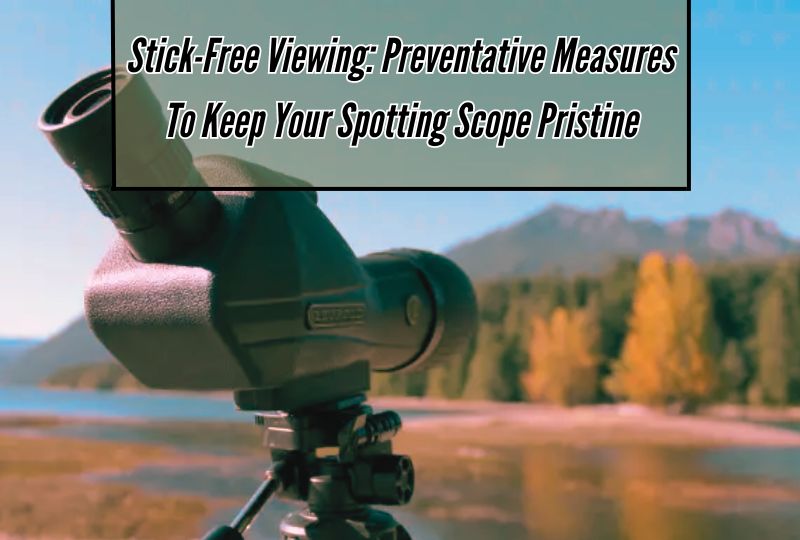You’re not the only one who has ever questioned why your spotting scope feels sticky. There are several possible causes of the stickiness, including environmental conditions and poor upkeep. Knowing the underlying causes is crucial to maintaining the longevity and optimum functioning of your equipment.
Why Is My Spotting Scope Sticky? A spotting scope may feel sticky for a number of reasons, including residue buildup from prior use, poor storage, and environmental conditions. Make sure to clean the scope on a regular basis using a gentle cloth and a moderate detergent solution to address this. Keep it out of direct sunlight and store it somewhere dry. Your spotting scope will remain in optimal condition for crisp vision with regular maintenance.
This post will examine the typical causes of sticky spotting scopes and offer workable fixes to resolve the problem. You may take advantage of crispr vistas and more seamless operation on your outdoor excursions by taking care of these problems. Let’s explore and determine the causes of your sticky spotting scope.
The Sticky Situation: Unraveling the Mystery Behind Your Spotting Scope’s Tackiness
When looking through your spotting scope, have you ever noticed any sticky residue? Its functionality may be impacted by this frequent problem.
To maintain your spotting scope in optimal working order, we’ll examine the reasons behind this tackiness in this post and consider workable fixes.
Understanding the Problem:
Tackiness on the scope’s surface is a typical problem that many users of spotting scopes have experienced. In addition to being annoying, this frequently raises concerns about the source of the issue and potential solutions.
Causes of Tackiness:
The stickiness of a spotting scope is influenced by a number of variables. Unfavorable environmental factors like excessive humidity or chemical exposure may be involved.
Furthermore, the materials—like rubber or specific kinds of coatings—that were utilized to make the scope could degrade with time and leave behind an adhesive residue.
Impact on Performance:
The scope’s tackiness can have an effect on both its usability and appearance. It might be challenging to adjust, impede fluid motion, and draw dirt and debris, all of which would exacerbate the issue.
Preventive Measures:
Adequate upkeep is essential to avoid or reduce tackiness. When not in use, keep the scope out of the kind of conditions that encourage stickiness by storing it somewhere cool and dry.
To maintain the integrity of the materials, clean them on a regular basis using a gentle soap and water solution instead of harsh chemicals.
Treatment Options:
There are actions you can do to resolve the problem if your spotting scope has already started to accumulate sticky residue. Isopropyl alcohol or certain cleaning solutions made for lenses can assist in removing the sticky residue without causing harm to the scope.
Make sure you adhere to the manufacturer’s instructions and stay away from products with abrasives that can scratch the coatings or lenses.
Seeking Professional Assistance:
If, in spite of your best attempts, the tactiness doesn’t go away, you might need to get expert help. With their specialized equipment and knowledge, optics specialists can evaluate the scope’s state and carry out any necessary repairs or refurbishments to get it back up and running.
Gooey Glitches: Understanding the Causes of Sticky Spotting Scopes

Spotting scopes offer clear magnification for target shooting, hunting, and birdwatching, making them indispensable equipment for both professionals and outdoor lovers.
On the other hand, using a “sticky” spotting scope might be annoying and interfere with your outdoor enjoyment. By knowing the reasons behind these annoying bugs, you may avoid them and maintain the best possible condition for your spotting scope.
Environmental Factors
Environmental factors are one common source of sticky spotting scopes. The moving components of the scope are susceptible to moisture, dust, and humidity infiltration, which can make them cling and make them less efficient.
Furthermore, high or low temperatures might have an impact on the lubricants inside the scope, which over time can cause stickiness.
Lack of Maintenance
Maintaining the best possible condition for your spotting scope requires regular maintenance. A buildup of waste and friction caused by lubricating and cleaning the moving parts might cause sticky functioning.
Sticky glitches can be avoided by performing basic maintenance procedures such as lens cleaning, joint lubrication, and safe scope storage.
Inferior Quality Materials
Sometimes employing subpar materials during manufacturing might lead to sticky spotting scopes. Over time, the scope may become sticky and challenging to adjust due to deterioration from subpar lubricants or poorly made components. Investing in a sturdy, high-quality spotting scope will help avert these problems.
Improper Storage
The performance of your spotting scope might also be affected by how you store it while not in use. Stickiness problems may worsen if the scope is stored in a wet or dusty environment as this can cause moisture and debris to accumulate.
It’s critical to keep your scope covered or in a clean, dry place and to protect it from the weather using covers or cases.
Overuse and Wear
Spotting scopes are mechanical devices, and as such, wear and tear can occur with lengthy usage. Sticky operation could result from the moving parts wearing out or being damaged over time.
You may extend the life of your spotting scope and avoid sticky glitches by checking it frequently for wear indicators and taking quick care of any problems.
Improper Handling
Spotting scope misuse or mishandling can potentially lead to sticky operation. Excessive force or rough handling when adjusting the scope might harm internal parts and make them stickier.
It’s crucial to use and calibrate your spotting telescope according to the manufacturer’s directions and to handle it with care.
Manufacturing Defects
Rarely, manufacturing flaws could be the cause of sticky spotting scopes. Operational problems, such as stickiness, might result from defective parts or assembly mistakes.
Should you continue to experience stickiness even with appropriate care and handling, it might be worthwhile to get in touch with the manufacturer for warranty support or repairs.
Sticky Scope Syndrome: Common Culprits and Solutions for Clear Viewing
Understanding Sticky Scope Syndrome
Sticky Scope Syndrome is a frustrating phenomenon that affects both amateur astronomers and telescope aficionados. It is characterized by a sticky or jerky image through the telescope that makes it difficult to navigate around the celestial landscape.
Although there are many reasons why this problem might occur, knowing who the typical offenders are will help you address it successfully.
Common Culprits of Sticky Scope Syndrome
Mount Misalignment:
Misaligned mounts are one of the main causes of sticky scope syndrome. Improper alignment of the mount with the celestial coordinates might cause chaotic movements and make it difficult to follow objects over the night sky with ease.
Mechanical Friction:
Friction buildup can occur gradually to mechanical parts of the telescope, like gears and bearings. The telescope’s movement may be hindered by this friction, making observations clumsy or unnatural.
Balance Issues:
The smooth functioning of a telescope depends on maintaining equilibrium. An unwarranted amount of tension on the mount due to unbalanced configurations might cause erratic motions and exacerbate sticky scope syndrome.
Environmental Factors:
The performance of the telescope can be impacted by outside factors such as humidity and temperature changes. These elements could contract or grow as a result of these circumstances, which would change how they move and aggravate sticky scope syndrome.
Optical Misalignment:
The view may occasionally become distorted or stuck due to misalignment inside the optical system. To fix this problem, meticulous calibration and tweaking could be necessary.
Solutions for Clear Viewing
Regular Maintenance:
Preventing sticky scope syndrome with regular maintenance on your telescope can assist. This entails maintaining correct mount alignment, lubricating mechanical components, and cleaning optical components.
Proper Balancing:
It is very important to pay attention to the balance of your telescope arrangement. Purchase counterweights and make the necessary adjustments to reach the ideal balance, which will lessen the load on the mount and the likelihood of sticky scope syndrome.
Temperature Control:
Keep your telescope in a stable space with regulated humidity and temperature to reduce the effects of outside influences. This can lessen the effects of heat contraction and expansion.
Precision Alignment:
Take the time to use alignment techniques or star alignment software to precisely align the telescope’s mount with the celestial coordinates. A proper alignment can minimize sticky scope syndrome occurrences greatly.
Optics Adjustment:
If you think there may be an optical misalignment, carefully make the required adjustments by consulting the telescope’s handbook or asking seasoned users for advice. A crisp and seamless viewing experience can be guaranteed by properly aligned optics.
Tackling Adhesive Anomalies: How to Combat Stickiness in Your Spotting Scope

Spotting scopes, which provide sharp and clear magnification of distant objects, are indispensable equipment for hunters, bird watchers, and outdoor lovers. Adhesive abnormalities, on the other hand, are a frequent problem with these optical devices that can impede your viewing experience and be frustrating.
Here, we’ll explore some practical methods for overcoming stickiness in your spotting scope to guarantee top performance and durability.
Understanding the Causes of Stickiness
Understanding the root reasons of stickiness in spotting scopes is crucial before attempting any remedies. A sticky or sluggish operation can frequently be caused by the accumulation of dust, dirt, moisture, or residue on lenses, focus wheels, or other moving parts.
Furthermore, these problems can be made worse by exposure to high temperatures or inappropriate storage, which eventually results in reduced functionality.
Investing in Quality Optics Cleaning Tools
Maintaining the functionality of your spotting scope can be greatly aided by having the appropriate gear on hand.
Purchase premium cleaning supplies for your lenses, including as lens pens, lens brushes, and anti-fog solutions, to efficiently get rid of tough residue and stop it from building up again. Adhesive materials and strong chemicals should not be used on sensitive lens coatings and seals.
Protective Storage and Transport Practices
Maintaining the integrity of your spotting scope and lowering the possibility of adhesive anomalies need careful storage and transportation. Purchase a sturdy carrying case or protective sleeve to keep your scope safe from collisions, moisture, and dust when traveling.
In order to stop materials and lubricants from degrading, keep your scope stored in a cool, dry place away from harsh sunlight and temperatures.
Seeking Professional Maintenance and Repairs
Even with your best attempts at cleaning and maintaining it yourself, adhesive abnormalities can still exist in some situations. It might be necessary to seek professional assistance if stickiness or mechanical problems persist.
To ensure optimal performance and dependability, have your spotting scope serviced by a manufacturer-approved service center or a trustworthy optics expert. They can identify and fix any underlying problems.
Solving the Stickiness Dilemma: Expert Tips for Spotting Scope Maintenance
Maintaining your scope will ensure that you shoot at your best. We’ll look at professional advice on identifying scope maintenance in this article.
We’ll go through everything you need to know to maintain your scope in peak condition, from regular inspections to cleaning methods and expert support.
Understanding the Basics
In order to ensure the best possible performance and longevity of your handgun, scope maintenance is an essential part of gun ownership.
Understanding the basics is crucial before diving into professional advice. An essential tool for precise aim, target magnification, and improved shooting accuracy is a scope.
Regular Inspection Routine
Following a regular inspection schedule is one of the most important aspects of good scope maintenance. You may identify any problems early on and stop them from getting worse by routinely inspecting your scope for any indications of wear, corrosion, or misalignment. Examine the general structural integrity, lenses, mounting, and screws.
Identifying Common Issues
It might be much easier to identify maintenance needs if you are familiar with frequent scope problems. Windage and elevation adjustments problems, misaligned reticle, cloudy or filthy lenses, and loose or broken mounts are a few examples. You can quickly handle emerging problems if you know what to look for.
Cleaning Techniques
Maintaining the usefulness and clarity of your scope requires careful cleaning. To prevent damage, it is imperative to utilize the appropriate methods and instruments.
For persistent stains or smudges, use specialized lens cleaning solutions instead of using a soft brush or microfiber cloth to gently remove the debris and grime. Keep sharp objects and strong chemicals away from lens coatings as they can damage them or erode them.
Calibration and Adjustment
For best results, calibrate and adjust your scope on a regular basis. To achieve this, zero the scope and make sure that, at a given distance, the point of aim and the point of impact line up.
Accuracy can also be improved by adjusting windage and elevation settings in accordance with environmental elements like wind speed and bullet trajectory.
Professional Assistance
Getting professional help may be required in some situations, particularly for intricate repairs or modifications.
Expert gunsmiths and opticians have the knowledge and specialized equipment needed to solve complex scope problems. If you run into problems that are outside of your area of knowledge, don’t be afraid to ask for professional assistance.
Stick-Free Viewing: Preventative Measures to Keep Your Spotting Scope Pristine

A spotting scope may be a very useful instrument for taking in the great outdoors and studying nature. But for maximum performance and life, it must be kept in immaculate shape.
The following are some practical precautions you may take to guarantee stick-free viewing and maintain the quality of your spotting scope:
Choosing the Right Location:
Selecting a suitable location can significantly impact the cleanliness of your spotting scope. Avoid areas with excessive dust, mud, or sticky substances that could potentially adhere to the lens or body of the scope. Opt for clean, stable surfaces whenever possible to minimize the risk of contamination.
Utilizing Lens Covers:
Clear and spotless spotting scope lenses are maintained with lens coverings, which act as a barrier against dust, debris, and moisture.
When the scope is not being used, always remember to apply lens covers—during storage as well as transit. This easy procedure can help keep foreign objects from sticking to the lens surface and impairing vision.
Regular Cleaning Routine:
You should make sure that you clean your spotting scope on a regular basis to preserve its integrity. Smudges, fingerprints, and dirt particles can be removed from lens surfaces using a soft, lint-free cloth and a mild lens cleaning solution. Do not use harsh chemicals or abrasive materials on lens coatings as they may scratch or hurt them.
Protective Carrying Case:
Investing in a premium carrying case made especially for spotting scopes can add an additional degree of security for storage and transit.
The integrity of the scope can be protected against unintentional bumps, scratches, and exposure to the outdoors with the use of a cushioned case that has accessory sections.
Minimizing Contact:
Reducing contact with the lens surfaces can aid in avoiding the build-up of debris, oils, and other impurities that could impair optical performance.
When handling the spotting scope, take care not to touch the lenses with your bare fingers. Before using a clean cloth to wipe the lens, use a lens pen or air blower to carefully remove any loose particles.
Weather Protection:
The cleanliness of your spotting scope can be seriously jeopardized by weather, especially when you’re going on an outdoor expedition. Keep in mind that certain weather conditions, including rain, snow, or excessive humidity, might raise the possibility of moisture accumulation and water damage. When the weather is bad, think about purchasing a waterproof and fog-proof spotting telescope or covering up with covers.
Routine Maintenance:
To spot any possible problems or wear and tear indicators, your spotting scope needs to be regularly maintained and inspected.
Examine the scope for any loose screws, broken seals, or other issues that can compromise its functionality or durability. By taking quick action to fix any problems, you can increase the longevity of your spotting telescope and guarantee that you will continue to enjoy stick-free viewing.
From Sticky to Smooth: Troubleshooting Tactics for Sticky Spotting Scopes
Your spotting scope’s flawless operation must be unlocked if you want to observe in the vast outdoors uninterrupted. We’ll look at straightforward yet efficient troubleshooting techniques in this article to address sticky mechanisms. Learn how to easily return your spotting scope to peak performance, from cleaning and lubrication to fine adjustments.
Understanding the Issue:
For birdwatchers, hunters, and nature lovers alike, spotting scopes are indispensable instruments that provide a closer look at far-off topics.
But a pleasurable excursion can rapidly become irritating if you run into a sticky focus or zoom mechanism. Finding the source of the stickiness is the first step in fixing the problem.
Cleaning and Maintenance:
Maintaining the best possible condition for your spotting scope requires routine maintenance. Over time, trash, dust, and other particles may build up and cause clinging or rigid movements.
This issue is frequently resolved by giving it a thorough cleaning with a soft brush or microfiber cloth. To get rid of more tenacious residue, use a light detergent diluted in water and thoroughly dry the area to avoid moisture damage.
Lubrication Techniques:
Your spotting scope’s performance can be greatly enhanced by lubricating its moving parts. To prevent drawing dirt and adding to the stickiness, it’s imperative to use the proper kind of lubricant and to apply it sparingly. For spotting telescopes, silicone-based lubricants are typically advised because they offer smooth functioning without leaving a greasy residue.
Precision Adjustment:
In certain cases, misalignment or incorrect adjustment of internal components might be the cause of sticky areas. Check and fine-tune the focus and zoom mechanisms to make sure they are operating properly by consulting the manufacturer’s handbook. Take care not to push changes through because this can harm fragile parts.
Temperature and Environmental Factors:
The viscosity of materials and lubricants can be impacted by extreme temperatures, which can result in slow or sticky performance. Steer clear of frigid weather or extended exposure to direct sunlight with your spotting scope.
Furthermore, you may protect your device from dust, moisture, and other environmental elements that cause stickiness by keeping it in a protective case while not in use.
Professional Assessment:
It could be time to get professional help if trying various troubleshooting techniques doesn’t work to fix the stubborn problem with your spotting scope.
Making contact with the manufacturer or a trustworthy optical specialist might yield competent advice and possibly reveal underlying problems that call for skilled repair or replacement parts.
Conclusion
In conclusion, don’t worry if your spotting scope is sticky. Most likely, it’s just dirt and residue that have accumulated over time from frequent use. Using a soft cloth and a mild soap solution, perform a gentle cleaning to address the problem. Recall to stay away from abrasive or harsh chemicals as they can harm the fragile optics.
Maintaining your scope’s cleanliness increases its longevity and enhances its function. So, accept cleaning as a necessary part of your regular upkeep, and you’ll continue to enjoy crystal-clear views for many years to come!
Frequently Asked Questions (Why Is My Spotting Scope Sticky)
What to do when rubber turns sticky?
Spotting scopes can function at night, but how well they perform depends on a number of things. The objective lens diameter of the scope, which affects how much light it can gather, is one of the most important variables. The performance of the scope in low light is improved by a larger objective lens diameter.
The quality of the optics and coatings also contributes to enhanced image brightness and clarity in low-light situations. Some spotting scopes also have night vision or low-light settings, which can improve their usability for nocturnal observations. When utilizing spotting scopes after dark, it’s crucial to remember that even with these features, they might not function as well as specialized night vision equipment.
Why is my spotting scope sticky after use?
After use, accumulated dirt, oils, or moisture may make your spotting scope feel sticky. A sticky residue may develop on the lens surfaces as a result of dust and debris collecting there over time. Moreover, the scope may feel slimy due to oils from your hands transferring to it. Use a moderate lens cleaning solution and a soft, lint-free cloth to clean the lens in order to fix this.
Be careful not to scrape anything. To avoid moisture buildup, store the scope somewhere dry. Maintaining the clarity of your spotting scope and ensuring a more seamless user experience can be achieved through regular cleaning and appropriate storage.
Can extreme weather affect my spotting scope’s performance and make it sticky?
Unpredictable weather conditions can affect your spotting scope’s functionality and make it sticky. Lubricants inside the scope may thicken in extremely hot weather, which would interfere with smooth operation. However, cold weather can cause lubricants to lose some of their fluidity, which makes modifications difficult. Humidity may also result in the buildup of moisture, which makes parts stick.
When your spotting scope is not in use, put it somewhere cool and dry, and make sure to clean and oil its moving parts on a regular basis to ensure optimal operation. This increases the longevity of your equipment and helps to guarantee smooth performance.
Is there a specific way to clean the lenses to avoid stickiness?
Use a microfiber cloth and a mild lens cleaning solution to avoid sticky lenses. Tissues and strong chemicals should not be used since they can harm the lens coating. First, use a blower to remove any loose particles, and then use a small amount of cleaning solution.
Make sure you have even coverage by wiping the lenses in a circular motion. Seek advice from your eyecare provider if the stickiness continues. Using this method of routine lens cleaning will help preserve clarity without causing any damage.
Can using lens caps or covers prevent stickiness on a spotting scope?
It’s true that utilizing covers or lens coverings can help keep a spotting scope from becoming sticky. Lens caps protect the lenses from elements including moisture, dust, and sticky materials that could degrade their performance. You can lessen the chance that sticky residues will attach to the lenses by keeping them covered while not in use.
This easy preventive action keeps your spotting scope clear and functional for longer lasting views. By using lens caps or covers on a regular basis, you may protect your equipment from environmental factors and potential stickiness that can affect optical performance.
Can a damaged or misaligned focus mechanism make the spotting scope feel sticky?
Yes, the sticky feeling in the spotting scope may be caused by a broken or misaligned focus mechanism. The focus mechanism is in charge of modifying the sharpness of your view; if it is broken or misaligned, trying to focus may seem tough or challenging.
The spotting scope may seem sticky or unyielding to adjustments as a result. To guarantee optimum performance and a more seamless user experience, it is advised that you get the focus mechanism examined and fixed by a specialist if you are having this problem.








